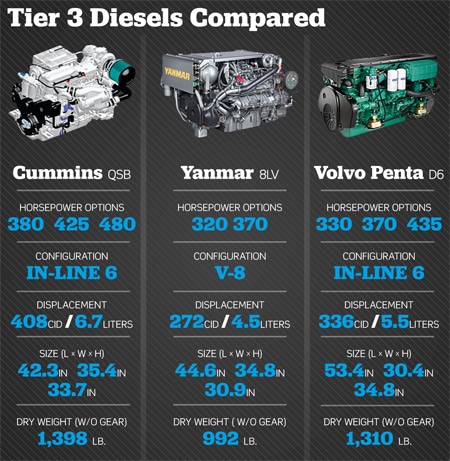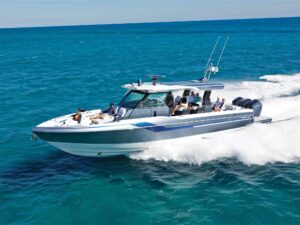Diesels are smelly, smoky and loud, right? Not if my advance trial of Cummins’ new 6.7-liter QSB common-rail diesel is any indication. This marine power plant offers clean, Tier 3 emissions as rated by the Environmental Protection Agency along with quiet operation and laudable fuel economy. The new in-line six-cylinder series debuts this summer in 380, 425 and 480 hp offerings, mirroring the current horsepower ratings of the 5.9-liter engine it replaces.
New federal EPA Tier 3 emissions standards require 55 percent fewer exhaust particulates and 17 percent less NOx — the industry designator that includes both nitric oxide and nitrogen dioxide. That translates to nearly unnoticeable exhaust. Cummins and other engine manufacturers reach these goals with common-rail fuel delivery, which supplies all injectors with full fuel pressure at all times. Older systems — even those with electronic governors — relied upon the position of the rotating camshaft to create fuel pressure only at the exact moment an injector fired. With a common rail, the injector becomes an electronic valve with limitless control over the time, shape and duration of each spray of fuel.
Common rail delivers a tiny charge of fuel after the main power injection to clean up exhaust, and a bit of fuel introduced before the main power injection to smooth out the preignition “rattle” heard on many diesels. When I was at the Cummins plant last fall to preview this new engine, engineers turned this “pilot injection” off, and then back on, so I could hear the difference — they claim an 83 percent reduction of noise and vibration at idle. I’ve supplied an audio clip of the engine running with and without pilot injection. You can hear it in the video below.
| |New Cummins 6.7 liter QSB diesel without and with “pilot injection” at idle, 1500 rpm and 2000 rpm.|
Aboard the test boat, a 44-foot express cruiser hull configured for quick engine changes, the new diesels proved quiet, and quick. With last year’s 5.9-liter engines, Cummins reported 0 mph to 20 mph acceleration in 14 seconds. I clocked the same boat to 20 mph in just eight seconds with the new 6.7-liter engines installed.
The simple fact is that this new engine shares only weight and rough dimensions with its predecessor. (The new engine is less than two inches larger in any dimension and about five pounds lighter.) A total redesign from turbo to pistons to cooling system leaves this engine with more torque and room to gain more ponies. Consider past launches from Cummins — the QSB 5.9-liter common-rail diesel was introduced in 2004 at 380 hp. It increased to 425 hp in 2006 and finally to 480 hp in 2008. The larger 8.3-liter QSC grew from its initial 480 hp with an electronic governor in 2003 and was up to 600 hp by 2007.
Fuel economy was close between the old and new engines as well, even though some engineers say EPA Tier 3 emissions compliance comes with a 10 percent penalty in fuel burned per horsepower produced. Better economy comes partly from newer fuel delivery technology coupled to smarter engines — the new engine’s electronic control module (ECM) is programmed with more than 10,000 lines of computer code versus a few dozen lines of code in older engine ECMs. This helped Cummins focus its efforts on fuel economy at cruise rpm, not wide-open throttle.
Simplified repair procedures make service more economical too. In fact, when operated with ultralow sulfur diesel (ULSD) sold here in the United States, the new engine requires service only every 500 hours, rather than the industry-normal 250 hours between oil changes.
Key Features
1. Compared with the 5.9-liter engine it replaces, the aftercooler cools intake air temperatures 30 percent more efficiently.
2. The cooling system was similarly souped up without increasing its size or weight.
3. Waste-gated turbo-size for mid-rpm performance also optimizes airflow at high rpm.









